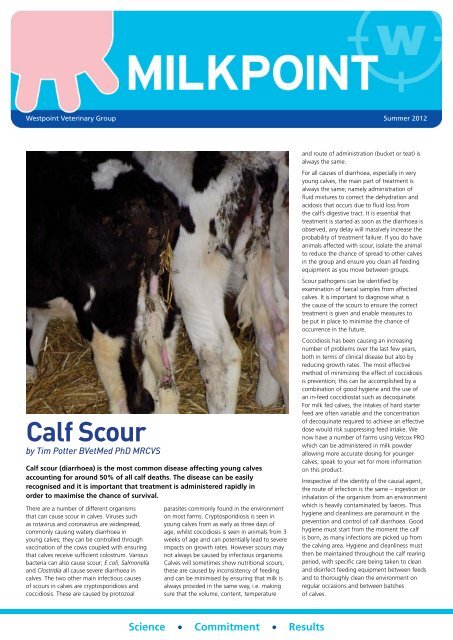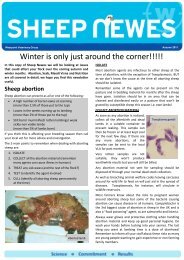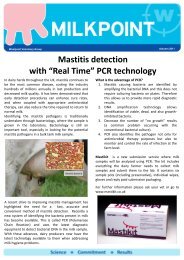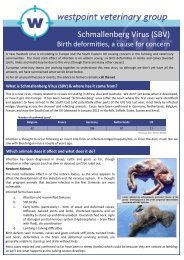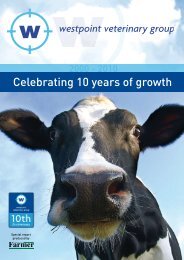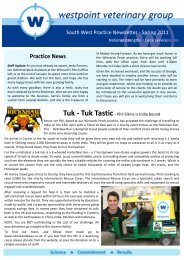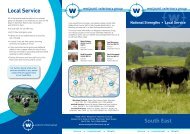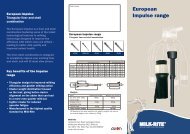Calf Scour - Westpoint Veterinary Group
Calf Scour - Westpoint Veterinary Group
Calf Scour - Westpoint Veterinary Group
- No tags were found...
Create successful ePaper yourself
Turn your PDF publications into a flip-book with our unique Google optimized e-Paper software.
<strong>Westpoint</strong> <strong>Veterinary</strong> <strong>Group</strong> Summer 2012<strong>Calf</strong> <strong>Scour</strong>by Tim Potter BVetMed PhD MRCVS<strong>Calf</strong> scour (diarrhoea) is the most common disease affecting young calvesaccounting for around 50% of all calf deaths. The disease can be easilyrecognised and it is important that treatment is administered rapidly inorder to maximise the chance of survival.There are a number of different organismsthat can cause scour in calves. Viruses suchas rotavirus and coronavirus are widespread,commonly causing watery diarrhoea inyoung calves; they can be controlled throughvaccination of the cows coupled with ensuringthat calves receive sufficient colostrum. Variousbacteria can also cause scour; E.coli, Salmonellaand Clostridia all cause severe diarrhoea incalves. The two other main infectious causesof scours in calves are cryptosporidiosis andcoccidiosis. These are caused by protozoalparasites commonly found in the environmenton most farms. Cryptosporidiosis is seen inyoung calves from as early as three days ofage, whilst coccidiosis is seen in animals from 3weeks of age and can potentially lead to severeimpacts on growth rates. However scours maynot always be caused by infectious organisms.Calves will sometimes show nutritional scours,these are caused by inconsistency of feedingand can be minimised by ensuring that milk isalways provided in the same way, i.e. makingsure that the volume, content, temperatureand route of administration (bucket or teat) isalways the same.For all causes of diarrhoea, especially in veryyoung calves, the main part of treatment isalways the same; namely administration offluid mixtures to correct the dehydration andacidosis that occurs due to fluid loss fromthe calf’s digestive tract. It is essential thattreatment is started as soon as the diarrhoea isobserved, any delay will massively increase theprobability of treatment failure. If you do haveanimals affected with scour, isolate the animalto reduce the chance of spread to other calvesin the group and ensure you clean all feedingequipment as you move between groups.<strong>Scour</strong> pathogens can be identified byexamination of faecal samples from affectedcalves. It is important to diagnose what isthe cause of the scours to ensure the correcttreatment is given and enable measures tobe put in place to minimise the chance ofoccurrence in the future.Coccidiosis has been causing an increasingnumber of problems over the last few years,both in terms of clinical disease but also byreducing growth rates. The most effectivemethod of minimizing the effect of coccidiosisis prevention; this can be accomplished by acombination of good hygiene and the use ofan in-feed coccidiostat such as decoquinate.For milk fed calves, the intakes of hard starterfeed are often variable and the concentrationof decoquinate required to achieve an effectivedose would risk suppressing feed intake. Wenow have a number of farms using Vetcox PROwhich can be administered in milk powderallowing more accurate dosing for youngercalves; speak to your vet for more informationon this product.Irrespective of the identity of the causal agent,the route of infection is the same – ingestion orinhalation of the organism from an environmentwhich is heavily contaminated by faeces. Thushygiene and cleanliness are paramount in theprevention and control of calf diarrhoea. Goodhygiene must start from the moment the calfis born, as many infections are picked up fromthe calving area. Hygiene and cleanliness mustthen be maintained throughout the calf rearingperiod, with specific care being taken to cleanand disinfect feeding equipment between feedsand to thoroughly clean the environment onregular occasions and between batchesof calves.Science • Commitment • Results
Confronting the Sleeping Giant –Tackling Johnes Disease in Your Herdby Jules Dare BVetMed MRCVSWhilst Johnes Disease has been knownabout for many decades in the dairy,beef and sheep industry, research hasshown that its impact on the health andproduction of herds across the countrymay well have been underestimatedfor some time.The disease is caused by the bacteriaMycobacterium avium subspeciesparatuberculosis (MAP) and work carried outby the VLA amongst others has estimatedthat about 35% of the national dairy herd isaffected by the disease. The classical symptomsof profuse diarrhoea and prolonged weight lossin animals generally older than two years ofage are well known to vets and farmers alike.Improvements in testing techniques suggestthat these symptoms may only represent thetip of the iceberg.Once infected with the MAP bacteria, animalsremain infected for life and will spread thedisease through their faeces intermittentlythroughout their time in the herd. The sheddingof the bacteria in infected cows’ faeces issporadic, but it is most likely at times of stresssuch as calving or concurrent illness. In fact,animals infected with Johnes Disease areconstantly battling the infection and thereforethey are more likely to suffer from mastitis,infertility or lameness compared to uninfected,healthy cows. There is also growing evidenceto suggest that the MAP bacteria is alsospread “in-utero” from dam to foetus duringpregnancy, as well as transmission from dam tocalf via the dam’s colostrum. By far the highestrisk periods for animals contracting the diseaseare neonatal or young calves, therefore otherpotential areas of transmission include:-l To young calves from:-l Bedding or teats contaminated by thedam’s faecesl Bedding or teats contaminated by othercow’s faeces in the same groupl Contaminated food or water troughsSo how do we tackle it? The best method isto combine a program of testing productiveanimals with controlling the main transmissionpoints on the farm, thus removing positiveanimals whilst minimising the risk of spreadingthe disease to those most at risk.Johnes Disease TestingDue to the slow development of the diseasewithin animals, there is usually little point intesting for it in stock less than two years of age.As we have already mentioned, the disease isshed intermittently in the faeces throughoutan animal’s lifespan. Such shedding is alsomirrored by the animal’s antibody levels to MAP.Therefore, although a positive antibody testfor the disease almost certainly means that theanimal is both infected and infectious at thetime of sampling, a negative result does notmean that the animal is definitely not infected;only that she is not infectious.The variable nature of the cow’s Johnesantibody status means that single, whole herdblood testing programs are usually of littlebenefit in their own right. Whilst it may identifythe odd positive animal, it will not show thatthe remainder of herd is not infected with MAP.However, regular herd screens over a periodof time will provide an accurate picture of theherd’s status, with each new result making thispicture clearer.You can also test cows’ faeces for JohnesDisease, either by bacterial culture (which takessome time) or PCR (which can quickly getexpensive), but these should only really be usedon the advice of your vet for specific cases. Dueto the intermittent nature of the productionof MAP antibodies, a bulk milk sample forantibody testing is meaningless if negative.The only significant result would be a highor mid positive one, which would indicate asignificant problem in the herd.Many of the main milk recording companiesoffer very cost effective quarterly testingpackages. Testing every milking animal fourtimes a year quickly builds up a picture of theherd’s Johnes status and, over time, assesses theimpact of disease control measures that havebeen put in place (see Figure 1).Once results are known, animals are put intothree groups – red (positive animals), yellow(inconclusive animals) and green (negativeanimals), with strict protocols in place abouthow and when animals can move betweeneach group. Depending on the percentageof the herd in each of the three groups,management protocols can then be developedto reduce the impact of the disease and itsspread in the herd.It is worth mentioning that MAP is closelyrelated to the bacteria which causes BovineTuberculosis (Mycobacterium bovis). To avoidthe possibility of “False Positive” results, bloodor milk samples for MAP antibody testingshould not be taken within 1-2 months of aherd TB test. In some areas of the country, thisis easier said than done, so please consult yourvet to discuss the best time to test.Management ProtocolsAs the largest risk period of disease transmissionis either when the calf is still a foetus in thedam’s uterus or when it is a neonatal animal,any control protocols need to focus on theseareas to reduce the spread of MAP. Theseprotocols need to be discussed in depth withyour vet, as they will vary in their practicalityfrom farm to farm. However, all of the areasbelow must be tackled head on, as if any of thedoors are left open then MAP will walk throughthem, and a lot of work would have been donefor nothing. Areas to be tackled include:-l Breeding programl Red cows ideally should not be bred fromagain, as any calf they have will have ahigh risk of exposure, either in the uterusor through the maternal colostrum.l Consider the breeding of yellow cowscarefully. They should be culled if theyfall down in other areas (e.g. udderconformation, lameness).l Calving housing or pasturel As calving is a major stress period forthe cows, they are more than likely to beELISA 116/10/2010ELISA 216/11/2010ELISA 315/2/2011ELISA 417/5/2011ELISA 516/8/2011ELISA 615/11/2011Infection <strong>Group</strong>on 15/1/2011-- 3.95 1.51 1.33 0.98 33.15 J4 ?7.94 7.23 10.65 3.91 2.93 62.53 J4 ?-- -- -- -- 1.10 36.87 J4 ?14.94 34.13 44.26 -- -- 24.88 J3 ?0.05 8.32 8.40 35.74 0.03 -- J3 ?4.21 -- 30.25 3.03 0.22 4.98 J2 ✓2.90 8.24 43.66 4.18 1.54 12.65 J2 ✓0.27 5.97 40.58 5.81 3.62 7.13 J2 ✓4.21 10.52 33.44 4.02 1.35 16.37 J2 ✓Figure 1. Quarterly individual milk antibody testing builds up a picture of infection in the milking herd.
infectious at this time if they areMAP positive.l If red cows are identified when they arein calf, they can be kept but must beaccommodated and calved away fromthe green and yellow cows.l Any offspring of red cows must not bekept for breeding.l Although a separate calving area isessential for red cows, depending on thenumber calving in the herd at any onetime, this might not mean extra expense.A separate field, away from the othercows, may well suffice.l Good hygiene in all calving areasis essential.l Raise food and water troughs to preventfaecal contamination.l <strong>Calf</strong> husbandryl Avoid pooling of colostrum, especiallyfrom red or yellow cows.l Remove calves as soon as possible afterbirth (ideally within one hour of birth),feed colostrum from green cows andrear on artificial milk powder.l Avoid the feeding of waste milk to calves.l Biosecurityl Do not buy in a problem! Sourcereplacements from accredited freeor low risk herdsl Don’t forget about the originsof your bulls!Unlike diseases such as BVD, Johnes Diseasecannot be eliminated from a herd in a oneor two year period. Any successful MAPcontrol policy must incorporate both testingand management elements, which will beimplemented for a 5 to 10 year period tomaximise the health of your herd. Trying tocut corners with either of these elements willinevitably lead to the program falling apartat some stage.There are a variety of different methods toproducing a successful herd health plan totackle the impact of Johnes Disease on yourherd. These vary from a piece of paper drawnup with your vet over a cup of coffee, to hightech computer and internet-based programswhich take your data and process them intovarious areas of colour which may occasionallyflash on your screen if they are considered veryimportant (the really impressive ones may eventext you if a colour changes).It does not really matter which one of theseyou decide to use on your farm, as long as youtackle both the testing and control areas fully,discuss the situation regularly with your vet(sometimes a simple, practical solution is betterthan a more expensive, drastic one) and thatthe records are up to date and easily visible toensure that no animals are missed and that theadopted plan is having the desired effect.Successfully targeting Mastitis with Mamyzinby Peter Aitken BVSc MACVS MRCVS‘Lee Valley Park Farm (Holyfield Hall) arecurrently milking around 125 cows in ayear round calving herd; milking twicedaily, with an average lactation yieldof approximately 8,800L in an 8 asideherringbone parlour. The farm is managedby Chris Evans, with Jason Painter as theherd manager and Bobby French as thehead stockman.There had been a problem within the herd ofcows recording with high individual somatic cellcounts (SCC) and yet showing no clinical signs.These had been treated (some using multipletreatments) but with no real resolution, andrepeated high SCC at further recordings wereoften detected.Last year, following discussion with their vetPeter Aitken, they made the decision to useMamyzin to treat cows with mastitis that hadbeen problematic. Cows that had failed torespond to multiple previous treatments wereidentified and a course of Mamyzin was usedto treat these problem cows. Mamyzin waschosen due to recommendations from Peterbased on recent data that had been presentedwhilst he was in New Zealand on drug plasmaconcentrations and efficacy; it was administeredto the problem cows due to the likely sensitivityof the bacterial pathogens suspected and thespectrum of cover offered by Mamyzin.Using Mamyzin at a dosing regimen of 1 x 10gBobby FrenchLee Valley – Holyfield Hall Farm (Main Shed)Jason Paintervial once a day for 4 days (15mg/kgBW), Bobbycommented on the fact that the response wasoften quite remarkable! Cows such as number5186 who had been recording around the900,000 mark had dropped following treatmentto below 100,000 and had stayed there, evenafter the dry period! This was not a one offeffect either with cows that are over 700,000at recordings and no clinical signs now beinggiven a course of Mamyzin routinely to bringthe subclinical infections under control. Rollingcell counts in the herd have now droppedfrom around 300,000 last year to around the160,000 mark this year.When asked how he had found the responseand recovery of cows following treatment,Bobby commented that “response wasexcellent… never have I known anythingeffecting such a good cure and have had asmuch confidence in using”. His advice toother farmers was that if you haven’t tried it,give it a go. Peter Aitken said that “althoughsome consider penicillin based products to besomewhat out dated now, due to the natureof Mamyzin, and if suitable concentrationsare delivered for sufficient time, penicillin willoften be effective against many of the mastitispathogens we commonly encounter… definitelyone to consider”.
<strong>Westpoint</strong> now offering new Complete16 mastitis detection PCR assayby Paul Daly BSc PhD BVMS MRCVSIdentifying the mastitis pathogens is traditionally undertaken through bacteriology,where the sample is grown in the laboratory.Bacteriology is still an important tool, especiallyin looking for the potential mastitis pathogensin a bulk tank milk sample. Culturing is alsoimportant in Individual cow samples.In addition <strong>Westpoint</strong> now provide rapidand reliable identification of mastitis-causingbacteria from bovine milk using state of the artmolecular biology techniques. The test is calledReal-Time Polymerase Chain Reaction (RT-PCR).The technique is rapid, accurate, reliable anddoes not require bacterial culturing.The PCR service now offers four additionalmastitis pathogens. These are Yeasts,Mycoplasma species,Mycoplasma bovisand ProtothecaAdvantages of PCR• No bacterial culturing required• Accurate identification of all major mastitiscausingpathogens• From sample to results in just four hours• High sensitivity, even for samples that show“no growth” in culture• Suitable for preserved milk samples• Can be used with milk recording samples• Samples can be shipped at roomtemperaturePathoProof MastitisComplete-16 Kit identifies:1. Staphylococcus aureus2. Staphylococcus spp. (including all majorcoagulase-negative staphylococci)3. Streptococcus agalactiae4. Streptococcus dysgalactiae5. Streptococcus uberis6. Escherichia coli7. Enterococcus spp. (including E. faecalisand E. faecium)8. Klebsiella spp. (including K. oxytocaand K. pneumoniae)9. Serratia marcescens10. Corynebacterium bovis11. Arcanobacter pyogenes andPeptoniphilus (Peptostreptococcus)indolicus12. Staphylococcal ß-lactamase gene(penicillin-resistance gene)13. Mycoplasma bovis14. Mycoplasma spp.15. Yeast16. Prototheca spp.180160140120170PCRs on No Growths1008060846540200StaphBeta lactamase37Staph aureus28C.bovis34231910371 2 3EcoliStrep uberisM.bovisA.pyogenesKlebsiellaStrep dysStrep agalactiaeSerratiaEnterococcusNegativeWESTPOINT VETERINARY GROUP Ltd.Dawes Farm, Bognor Road, Warnham, West Sussex RH12 3SHTel: (01306) 628086 Fax: (01306) 628080www.westpointfarmvets.co.ukScience • Commitment • Results


